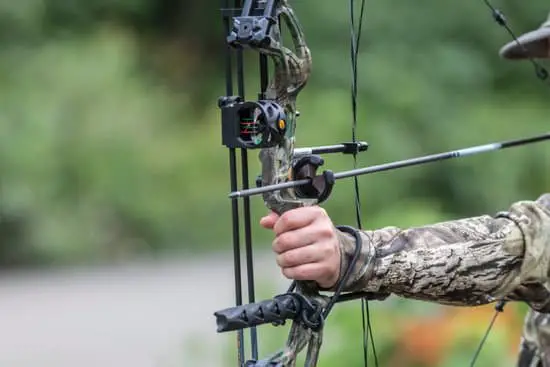One of the major issues faced by a new archer while buying their bow is to get the right draw weight. Measured in pounds, the draw weight is identified with the amount of force required to draw the bow towards the anchor position. The archer mustn’t over-bow.
When you have the right draw weight or poundage, it protects you from soreness, muscle fatigue, and cramping. Moreover, you will have an exciting experience while learning the sport. Too light or too heavy draw weight greatly influences your desire and learning spirit towards the sport.
One method to find out the best poundage low bow is to shoot with 15 pounds lighter compared to the draw weight of your compound bow. The second method is to find out the draw length to know the bow length. Other methods include the 30-seconds test.
The article will guide you through various methods over how to find the correct draw weight or poundage. Additionally, we will discuss how to improve the overall draw weight. So, if you want to feel connected with the essence of the game and enjoy the simplicity of the longbow, your journey starts with finding the right draw weight.
What Is The Ideal Draw Weight?
Each bow comes with a different draw weight. You can adjust the draw weight of some compound bow with over 50-pound to 15-56 pounds, while you can adjust some smaller bow’s poundage range to only ten pounds.
Like the bow, each person’s ideal draw weight is different. Some archers can easily pull more than 70 pounds, while some can pull 30 pounds. The proper bow weight can affect the archer’s physical ability and experience to help increase the total control of the bow’s draw cycle. With that, they can execute accurate and consistent shots perfectly.
Determining The Right Draw Weight
The method for selecting the right draw weight is the same for every archer, irrespective of their gaming skills. Before selecting the draw weight, you should know yourself and your gaming techniques by asking the following questions:
- Your overall experience in archery? Are you a beginner or an expert?
- Whether you practice archery weekly or monthly?
- Do you actively take part in other sports as well?
- What bow size and draw weight do you practice with?
- Are you playing for competing with other archers?
- Your goals for playing archery?
Once you answer each question, you can move on to the next step to find your exact bow requirement and ideal draw weight.
There are various methods available on the internet to find out the perfect draw weight. First and foremost, always observe your body type before you determine the draw weight. Then, you will know how much weight you can effectively pull.
Charts
Charts are one of the most popular and easiest methods to find the right draw weight. You can find the charts on the internet easily. However, with so many charts, it becomes difficult to identify what is accurate and what is not.
Some charts include body height and weight to determine the draw length. There is no logical reasoning behind this. You can be tall and heavy but still unable to draw the heavy bow due to weak muscle. Or, you can be lightweight and small but can draw the heavier bow due to strong muscles. It varies from individual to individual.
Identify The Draw Weight With Draw Length And Bow Length
The best way to determine the right draw weight is through the length of the longbow. You can look at the chart that shows the relationship between the longbow’s length and the draw length.
- When the bow length is 64 inches, the ideal draw length is below 24 inches.
- When bow length is 66 inches, the ideal draw length is between 24-27 inches.
- When bow length is between 66-68 inches, the ideal draw length is between 27-28 inches.
- When bow length is between 68-70 inches, the ideal draw length is between 28-30 inches.
- Lastly, for 70-72 inches bow length, the ideal draw length is more than 31 inches.
If you don’t know the draw length, you can easily measure it. Measure the length of your arm from side to side, covering all the fingertips. Then, divide the number by 2.5, and you will get your draw length.
Identify The Draw Weight With Body Type
For some people, draw length doesn’t hold much importance to determine the draw weight. For experienced archers, they know the ideal draw weight for a compound bow should be less than 15 pounds.
If you are an amateur, the below-mentioned information might be helpful to you. Now, we will show how your body type determines what the right draw weight is for you.
- If you belong to the group of males weighing over 190 pounds, the recommended suggested draw weight is 65 to 70 pounds.
- For most males weighing 160-190 pounds, the recommended draw weight is 55-60 lbs.
- For young boys and women with large body frames weighing 140-160 pounds, the recommended draw weight is 40-50 pounds.
- For large framed boys and women weighing 100-140 pounds, the recommended draw weight is 30 to 40 pounds.
- For a child weighing 70-100 pounds, the recommended draw weight is 15 to 20 pounds.
- For a small child weighing 40-70 pounds, the recommended draw weight is between 10 to 15 pounds.
30-Seconds Test
What is exactly a 30-second test? In this test, you need to pull the bow back at full draw and hold the position for exactly thirty seconds.
Whenever you went to a shop looking for a bow, it is pretty apparent that you don’t spend enough time to find the right bow concerning your ideal draw weight. If you quickly draw the bow once, you declare it as your perfect draw weight.
In archery, you don’t shoot the bow once but multiple times. You must be practicing for a competition or go hunting. The last thing you want from your bow is the heavy draw weight. If you don’t have the right draw weight, your muscles will suffer the consequences.
So, while trying the 30-second test, if you can’t handle the bow within the given time frame, the bow weight is not ideal for you.
How To Determine If You Over-Bow?
Do you know the ideal draw weight that the ancient English longbow archers used to handle? They often deal with 160-180 lbs. of draw weight as their bow length ranges from 11 inches or six feet.
Now, you do not find many people shoot a bow that has 180 pounds of draw weight. Still, some people can pick the heavyweight when it comes to showing their advanced skills in archery.
But, how do you determine if the draw weight you have selected for yourself is not too heavy? With over-bow or over-bowing, you can observe the bow’s heavy draw weight and switch to a more suitable bow as per your ability and strength.
There are two ways to identify if the draw weight is heavy for you or not:
- The first is to perform the 30-second test by pulling the string of the bow towards your waist.
- The second is to aim your bow towards the sky to pull it backward on the full draw. If you cannot pull back while you aim at your target, the bow is heavy for you.
In both cases, if you feel your shoulders are collapsing and you are exhausted after one round. They indicated that the selected draw weight is too heavy.
If none of the methods helped you confirm if you are drawing excess weight, then there is one more way. Try to bend at the waist while you aim the bow to the ground from inside your knees. If it is challenging for you to perform, it should be obvious to you that the draw weight is too heavy for you.
Below, you can find some crucial tips to keep in mind while selecting the new bow or upgrading the old one based on draw weight:
- Make sure that bows should not put excess strain on your undeveloped joints and muscles.
- Too heavy draw weight will not let the archer learn proper shooting skills.
- Practicing on low draw weight will develop the motor skills and smoothens your learning process.
- Shooting with heavy draw weight can cause physical injury.
- It is important to develop good muscle memory and perfect the shot cycle to execute shooting with exceptional precision.
- Repetitive practice at lower draw weights helps build good muscle memory while making it easy to perform the shot cycle.
Archers Competing With Draw Weight
In any sport, there is always a competitive spirit among the players. Archery is more of a mental game requiring concentration. Still, heavier draw weight comes with its advantages. That is why you see many archers boasting their draw weights. With more draw weight, you can deliver and hit your target with more power.
It is easy to feel discouraged and demotivated if you cannot handle heavy draw weight. But before you think about changing your bows, take a moment’s pause and think. In target competitions, does heavier draw weight make you win? You would probably don’t require heavier draw weight as your bow to win.
It is not only the draw weight that matters; it is the accuracy with which the arrow is delivered by the bow to hit the target. That is the reason why experienced and professional archers choose longbows because of their exceptional accuracy.
The simple reasoning behind the choice for the longbow is that the bow’s body is quite heavy while they are precisely thin. Because of the heavier body, the bow can correct any miscalculations or mistakes to result in an accurate shot. Also, it eliminates torque that can affect the accuracy and speed of the bows.
Therefore, what matters is how accurately you perform your shot rather than being involved in heavier draw weights and end up straining your muscles.
How To Increase The Draw Weight?
Suppose you are shooting with the same bow for months now and are considering increasing the weight. But how do you know when to increase the draw weight and how to do it.
It would help if you increase your draw weight when:
- Your current draw weight doesn’t allow you to shoot for further distances.
- You are unable to shoot accurately with your arrows.
- You can shoot for an extended period without straining your muscles.
If you are a beginner, firstly, you should start with your ideal draw weight bow. If you can practice consistently without any strain, you can proceed to increase the draw weight. If you are shooting regularly two times a week, increase the weight by two pounds. This way, your muscles will have enough time and practice to become strong.
Archery Exercise To Increase Your Draw Weight
It is always beneficial to perform archery strength exercises along with other bodily exercises to make your upper body ready to handle the heavier draw weight. Therefore, we will discuss some of the basic archery exercises that will help you to increase your draw weight.
Frequent Shooting
There is no other archery exercise better than frequent shooting to increase the draw weight. If your technique and stance are in proper form, then regular shooting will help make your archery muscles strong. Keep practicing at short distances more frequently and remember the technique to draw first and then release.
For this exercise, use the draw weight you are already practicing. It is because you can hurt yourself if you start increasing the weight too fast.
Push-Ups
Another effective archery exercise to strengthen the muscles is push-ups. You can perform push-ups anywhere, and they come in different varieties to focus on particular muscle groups.
If you are new, try the standard push-ups first and then move on to the triangle, wide-arm, raised, and lastly, decline push-ups. When you have become an expert in push-ups, you can also try a one-arm variety.
Push-ups help to ease your muscles to perform the process of the draw and release effortlessly. If you do push-ups consistently, it gives you enough boosts to increase your draw weight in less time. Practice multiple sessions in different sets at regular intervals every day while increasing the number of the set after a gap of few days.
Pull-ups
One of the oldest archery exercises, pull-ups, helps increase the draw weight by working on your upper muscles. If you are unable to enroll in the gym, you can pick any pull-up bar or rod and place it anywhere in your home to practice. Make sure that you use the upper body strength while doing pull-ups.
Like push-ups, you can increase the number of the set after a few days. Remember that if you don’t feel your muscles stretching, it means that pull-ups are not working for you. Try to reach the maximum limit at regular intervals throughout the day.
Versatility Of longbows
Whether you are considering increasing the draw weight or changing the current draw weight, you should evaluate the effectiveness of longbows. Longbows are the most preferred bows by professional and most experienced archers due to their straightforward design. It comprises of a string and a stick.
As the name suggests, the longbow has quite a long length in comparison to other bows. The length of the bow remains the same, unlike the compound bow, which shrinks over time. The longbow comes in a D shape, where the string does not touch the bottom and top limb.
With modern counterparts, compound, and recurve bows, the longbow isn’t that versatile as it is thought to be. With compound and recurve bows, you can easily increase draw weight by adjusting its parts, which is impossible in longbows.
Comparison Between A Recurve Bow And longbow
Let’s take a closer look at why longbows are more adaptable and preferred choice than recurve bows in specific areas.
Size And Curves
As we already mentioned, longbows are greater in length than recurve bows. In fact, you may not find any other bow as long as longbows.
The bows are called recurve because they are curved out at the bottom and top limb. On the other hand, the longbows are not curved, and their strength depends on their length, which generates enough energy to shoot the arrow.
Sound
As recurve bows are curved, the string attached to the bottom and top limbs touch each other. So, when you shoot the arrow, they tend to make more noise as the string comes in contact with each other. Whereas the string in the longbows does not touch the bottom and top limb, they do not make such loud noise.
Reach
longbows are excellent for further distances as they can make use of higher draw weights. They are generally used while hunting or at competitions.
Final Thoughts
Archery can be more exciting when your shots are more precise and accurate. And this accuracy comes with the right draw weight. Always keep in mind your control and comfort level with the bow that it has enough stopping power, distance, and speed while considering whether you need to increase the draw weights or not.
What did you learn from this article? You learned that your body could tell you how much pressure it can handle. Your aim should be to enjoy the activity and refurbishing your skills without straining your body. Take the draw weights seriously and follow our guidelines, as mentioned in this article, to enjoy the archery experience like never before.






